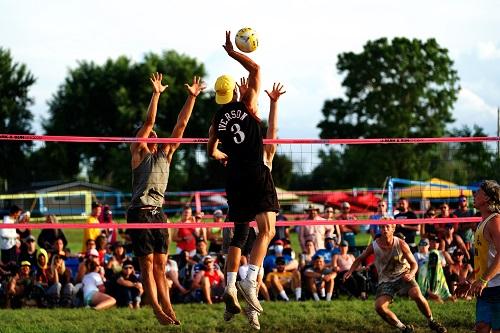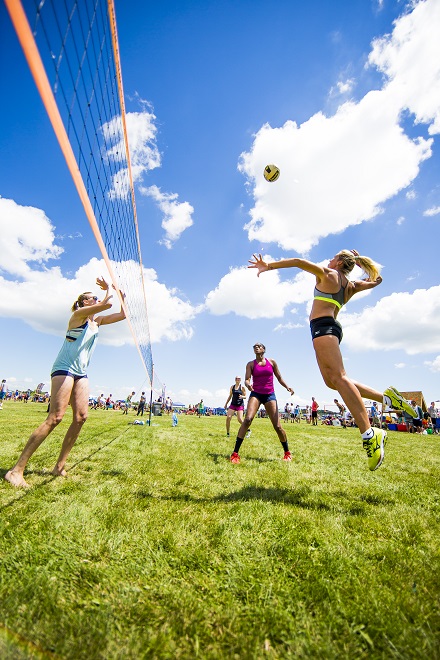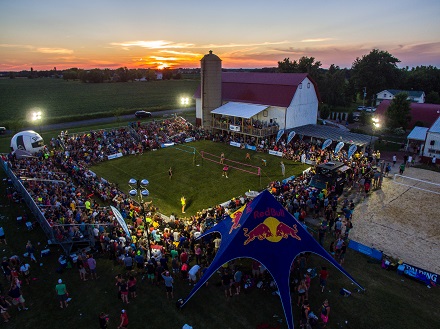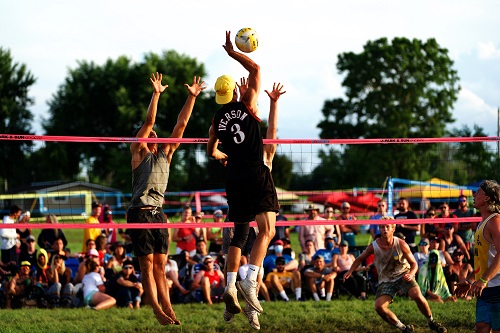
The Waupaca Boatride Volleyball Tournament, also known as the U.S. Open of Grass Volleyball, is held annually over the second weekend of July, and is the world’s largest outdoor volleyball tournament, with more than 1,000 teams traveling in for five days of volleyball (on both grass and sand), camping and live entertainment. The tournament, which began in 1984, includes both sand and grass play, for single-sex as well as co-ed teams, and offers divisions for juniors and adults in various skill levels. For the last several years, the event has been held at Brighton Acres, in Oshkosh, Wisconsin.
In 2020, however, as many event owners hunkered down, Waupaca was forging ahead and writing their own success story. While the event was scaled back to accommodate health guidelines, it boasted sellout registration, with more than 1,000 waitlisted teams and was greeted by an overwhelmingly positive pool of players.
Sports Destination Management: Your event took place from July 9-12 of this year, only a few months after everything shut down. That must have been incredibly challenging.

SDM: It was great you didn’t have to cancel.
Galecke: We actually had to cancel some games on Friday but that was because of rain, not because of anything else.
SDM: How many teams did you have, ultimately?
Galecke: We were still over 1,200 teams so that is pretty good size. We also had over 1,000 teams on the waitlist.
SDM: A total of 1,200 teams is great! Did you have to turn away players? You have an enormous group of people for whom it’s a fixture on their calendar.
Galecke: I would say cutting attendance back was the hardest part. I hated doing it. I hated telling people they couldn’t play this year. People were saying, “But I’ve played in this tournament for 20 years…” although they generally ended up by saying “I understand; we’ll see you next year.” They were good about it because they know everyone was going through it at the same time.
SDM: So there were no hard feelings?
Galecke: I think people were disappointed, but they knew our restrictions were being dictated by the powers that be. And even then, people were glad to see a tournament was happening.
SDM: You said you had a big waitlist. Were you able to accommodate any of them?
Galecke: We had a lot of teams that drop out leading up to the tournament; every day, we were getting about eight to ten drops. People weren’t comfortable or someone on their team had to be quarantined; there was a lot of change. We also made it so that all the way up to your game time, you could drop out and get a 100 percent refund, no questions asked.
SDM: Another big change was in the tournament accommodations; usually, you have people camping.
Galecke: Yes – but it was going to be really hard to enforce social distancing with that. You get people moving from campsite to campsite and having big parties; it wasn’t realistic. We decided to work with the Hawthorne Suites in Oshkosh as the official host property. That actually worked out well because they were 100 percent full during the tournament, and up until then, they’d been 10 to 20 percent full at the most. A few other places in the area also sold out during the tournament so it was really good to be able to do something for the Oshkosh area. A lot of their large music festivals and big events had dropped out. We were the only thing that went on over the summer.

Galecke: Let’s see; we got rid of the grandstands to avoid crowding and we switched over to water canisters that you operated with a food pedal if you wanted to fill up your water bottle. Instead of our plastic mugs, we gave out hand sanitizer with our logo on it.
Something else we did was allow people to check in on their phones when they arrived so that they didn’t have to line up in front of a table or anything like that.
We provided individual bottles of water and asked that people wear masks on site – basically, we tried to make it so that people could follow the rules according to their comfort level.
SDM: Did people wear masks when they were playing?
Galecke: We noticed there were 10 to 20 percent who would wear masks when they played, and that others would wear them when they were walking around. We asked them to wear masks and we supplied them so that it would be easier for everyone.
SDM: Were they good about it?
Galecke: They were. That’s really the great thing about the volleyball world; people are very respectful of each other’s wishes.
SDM: On another topic, what advantages do you think the outdoor game has over the indoor game?
Galecke: The outdoor game teaches players a lot more control; because you’re playing in triples and fours, you have a lot more opportunity to touch the ball more. You also learn to play in variable conditions; the wind, the elements – all things you don’t get with the indoor game.

Galecke: We do; we might do a showcase event this year. It’s unique in our tournament because the coaches actually play you.
SDM: Do you do livestreaming?
Galecke: Not exactly livestreaming but we work with a company that records games and has live scoring, shows different angles of play and at the end of the tournament, they can create a package that players can take home to send to coaches.
SDM: You said earlier that people were glad to play again. How did you feel about the whole thing?
Galecke: I think it went really well. The people who came were overjoyed to be there. They were so happy to be able to get back to normal life. Everyone wants some kind of normalcy, like going out, going to concerts and playing in tournaments. Not being able to do that took a toll on a lot of people. We were lucky that we were really able to sell out our event, and we really had the ideal situation. We were outdoors, we had acres and acres of parking and we had the ability to show that you CAN do something safely if you try. The authorities put their trust in us to run the event safely and we did. There were no bad reports, and not a single case from this. We’re already working on planning the 2021 tournament.

 www.waupacaboatride.com
www.waupacaboatride.com